
Wat Phra Kaew, commonly known in English as the Temple of the Emerald Buddha and officially as Wat Phra Si Rattana Satsadaram, is regarded as the most sacred Buddhist temple in Thailand. The complex consists of a number of buildings within the precincts of the Grand Palace in the historical centre of Bangkok. It houses the statue of the Emerald Buddha, which is venerated as the country's palladium.

The Wudang Mountains consist of a small mountain range in the northwestern part of Hubei, China, just south of Shiyan. They are home to a famous complex of Taoist temples and monasteries associated with the god Xuanwu. The Wudang Mountains are renowned for the practice of Tai chi and Taoism as the Taoist counterpart to the Shaolin Monastery, which is affiliated with Chinese Chán Buddhism. The Wudang Mountains are one of the "Four Sacred Mountains of Taoism" in China, an important destination for Taoist pilgrimages.

White Horse Temple is Buddhist temple in Luoyang, Henan that, according to tradition, is the first Buddhist temple in China, having been first established in 68 AD under the patronage of Emperor Ming in the Eastern Han dynasty.

The Longxing Monastery or Longxing Temple is an ancient Buddhist monastery located in the town of Zhengding in Hebei Province, China, approximately 15 kilometres (9.3 mi) north of the provincial capital of Shijiazhuang. It has been referred to as the "Best Temple south of Beijing".
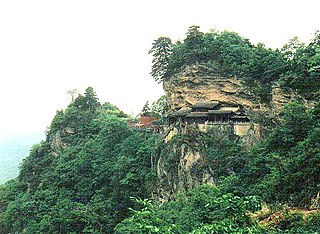
The Nanyan Temple is a temple in Wudang Mountains, Danjiangkou, Hubei, China. It is known as the place where Emperor Zhen Wu found Taoism and flew to heaven. The whole structure - hall-pillars, beams, arches, gates and windows - is created out of rock.
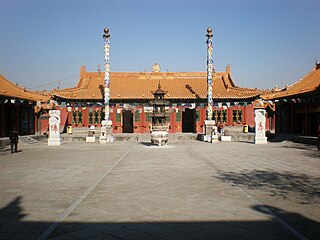
Da Zhao Temple or Wuliang Temple, or Ih Juu in Mongolian, is a Tibetan Buddhist monastery of the Gelugpa order in the city of Hohhot, Inner Mongolia in North China. It is the oldest and largest temple in the city and is located West of Danan Street in the Yuquan District.
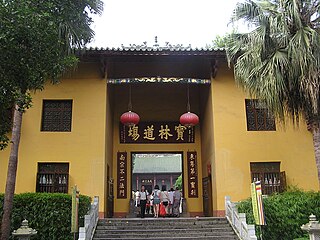
Nanhua Temple is a Buddhist monastery of the Chan Buddhism, one of Five Great Schools of Buddhism where Huineng, the Sixth Patriarch of Chan Buddhism, once lived and taught. It is located in the town of Maba (马坝镇), Qujiang District, 25 km (16 mi) southeast of central Shaoguan, Guangdong province. The location is in the northern part of the province, within a few kilometers from the Bei River.

The Gandantegchinlen Monastery is a Mongolian Buddhist monastery in the Mongolian capital of Ulaanbaatar that has been restored and revitalized since 1990. The Tibetan name translates to the "Great Place of Complete Joy". It currently has over 150 monks in residence. It features a 26.5-meter-high statue of Avalokiteśvara. It came under state protection in 1994.

The Fayuan Temple, situated in the southwest quarter of central Beijing, is one of the city's oldest and most renowned Buddhist temples.

Kaiyuan Temple is a Buddhist temple in West Street, Quanzhou, China, the largest in Fujian province with an area of 78,000 square metres (840,000 sq ft). The main statue in the most important hall is that of Vairocana Buddha, the main Buddha according to Huayan Buddhism. What is now called the Mahavira Hall is in fact the Vairocana Hall.

The Jinding, elevation 3,077 metres (10,095 ft), is the main peak of Mount Emei, a UNESCO World Heritage Site in Sichuan, China. It is also a common name for the Buddhist Huazang Temple built on the summit. Jinding is the highest Buddhist temple in traditionally Han areas of China.

The Xiantong Temple is a Buddhist temple located in Taihuai Town of Wutai County, Shanxi, China. The temple covers a total area of about 80,000 square metres (860,000 sq ft), it preserves the basic architectural pattern of the Ming and Qing dynasties (1368–1912). The temple has over 400 buildings and the seven main halls along the central axis are the Guanyin Hall, Great Manjusri Hall, Great Buddha Hall, Amitaba Hall, Qianbo Hall, Copper Hall and Buddhist Texts Library. Mount Wutai has 47 Buddhist temples, it is the largest Buddhist complex in China, Xiantong Temple is the largest one with the longest history.
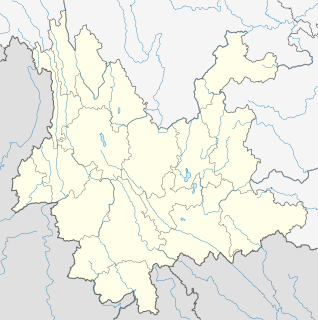
Mange Temple is a Buddhist temple located in Jinghong of Xishuangbanna Dai Autonomous Prefecture, Yunnan, China. Covering an area of 1,300-square-metre (0.32-acre), the temple is bordered by Lancang River in the north. Built in 1477, the temple is one of the oldest temples in Xishuangbanna Dai Autonomous Prefecture.

Caotang Temple is a Buddhist temple located on the north hillside of Mount Guifeng, in Huyi District of Xi'an, Shaanxi, China.

Zhiyuan Temple is a Buddhist temple located on Mount Jiuhua, in Qingyang County, Anhui, China. Alongside Ganlu Temple, Baisui Palace and Dongyan Chan Temple are honoured as the "Four Buddhist Temple on Mount Jiuhua".

Zhenru Temple is a Buddhist temple located in Putuo District of Shanghai, China. It is a Major National Historical and Cultural Site in Shanghai.
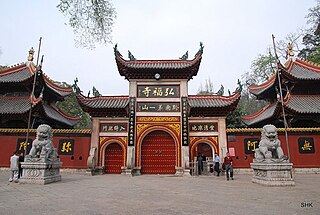
Hongfu Temple is a Buddhist temple located on Mount Qianling, in Yunyan District of Guiyang, Guizhou, China. Hongfu Temple and Qixia Temple are collectively known as the "Two Attractions in Guiyang".
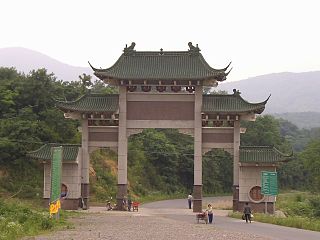
Longchang Temple is a Buddhist temple located on Mount Baohua, in Baohua Town of Jurong, Jiangsu, China. It is the cradle of Chinese Buddhism Risshū. The temple is renowned not only for its Copper Hall and Beamless Halls, but also for the 400-years-old ginkgo trees.

Longshan Temple is a Buddhist temple located on the foot of Mount Long in Anhai Town of Jinjiang, Fujian, China. The eldest thing in the temple is the statue of Thousand-armed and eyed Guanyin, which was supposed carved by ancient Indian monk Yilisha (一粒沙). It was transformed and expanded many times throughout Chinese history till now. There are dozens of which are built after the Ming dynasty (1368–1644). Longshan Temple is the ancestral temple of 400 Buddhist temples with the same name in Taiwan.

Lingguang Temple is a Buddhist temple located on the east hillside of Mount Cuiwei (翠微山), in the Shijingshan District of Beijing. The temple is renowned for its collection of the tooth relic of the Buddha.



















